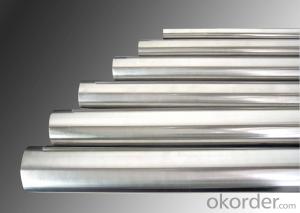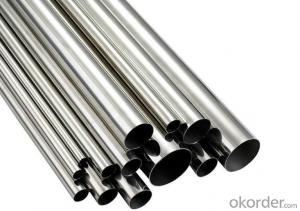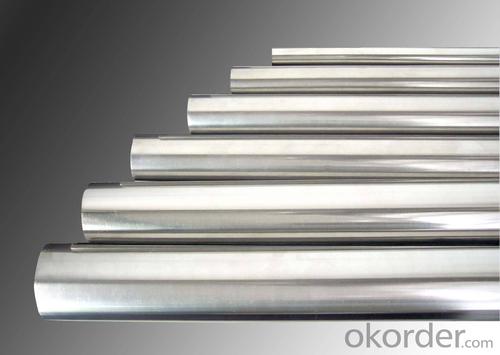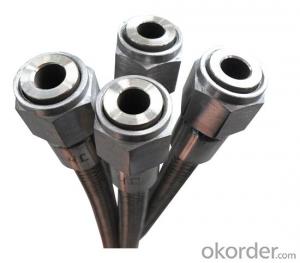Cold Drawn API Thin Wall Stainless Steel Pipe
- Loading Port:
- Tianjin
- Payment Terms:
- TT OR LC
- Min Order Qty:
- 35 m.t.
- Supply Capability:
- 5000 m.t./month
OKorder Service Pledge
OKorder Financial Service
You Might Also Like
Item specifice
Cold Drawn API Thin Wall Stainless Steel Pipe
1.Structure of Stainless Steel Pipe:
Seamless pipe is formed by drawing a solid billet over a piercing rod to create the hollow shell. As the manufacturing process does not include any welding, seamless pipes are perceived to be stronger and more reliable. Historically seamless pipe was regarded as withstanding pressure better than other types, and was often more easily available than welded pipe.
2.Main Features of the Stainless Steel Pipe:
• High manufacturing accuracy
• High strength
• Small inertia resistance
• Strong heat dissipation ability
• Good visual effect
• Reasonable price
3.Stainless Steel PipeSpecification:
Standard | GB, DIN, ASTM ASTM A106-2006, ASTM A53-2007 |
Grade | 10#-45#, 16Mn 10#, 20#, 45#, 16Mn |
Thickness | 8 - 33 mm |
Section Shape | Round |
Outer Diameter | 133 - 219 mm |
Place of Origin | Shandong, China (Mainland) |
Secondary Or Not | Non-secondary |
Application | Hydraulic Pipe |
Technique | Cold Drawn |
Certification | API |
Surface Treatment | factory state or painted black |
Special Pipe | API Pipe |
Alloy Or Not | Non-alloy |
Length | 5-12M |
Outer Diameter | 21.3-610mm |
Grade | 20#, 45#, Q345, API J55, API K55, API L80, API N80, API P110, A53B |
Standard | ASME, ASTM |
1) Material:20#(ASTM A 106/A53 GRB.API5LGRB,GB),45#,16Mn,10#.
2) Specification range:OD:21.3-610mm,WT:6-70mm,length:6-12m or according to the requirement of clients.
3) Excutive standards:GB,ASME API5L.ASTM A 106/A53,Despite of the above standards,we can also supply seamless steel pipe with standard of DIN,JIS,and so on,and also develop new products according to the requirements of our clients!
4) Surface:black lacquered,varnish coating or galvanized.
5) Ends:Beveled or square cut,plastic capped,painted.
6) Packing:bundles wrapped with strong steel strip,seaworthy packing.
4. Packing and Delivery:
Packaging Details: | seaworthy package,bundles wrapped with strong steel strip |
Delivery Detail: | 50-60days after received 30%TT or Original LC |
5. FAQ of Stainless Steel Pipe
A. How is the quality of your products?
Our products are manufactured strictly according to national and internaional standard, and we take a test on every pipe before delivered out. If you want see our quality certifications and all kinds of testing report, please just ask us for it.
Guaranteed: If products’ quality don’t accord to discription as we give or the promise before you place order, we promise 100% refund.
B. How about price?
Yes, we are factory and be able to give you lowest price below market one, and we have a policy that “ for saving time and absolutely honest business attitude, we quote as lowest as possible for any customer, and discount can be given according to quantity”,if you like bargain and factory price is not low enough as you think, just don’t waste your time.Please trust the quotation we would give you, it is professional one.
C. Why should you chose us?
Chose happens because of quality, then price, We can give you both.Additionally, we can also offer professional products inquiry, products knowledge train(for agents), smooth goods delivery, exellent customer solution proposals.Our service formula: good quality+good price+good service=customer’s trust
SGS test is available, customer inspection before shipping is welcome, third party inspection is no problem.
Any question, pls feel free to contact us !
6.Stainless Steel Pipe Images:

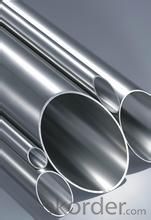
- Q:What are the specifications for stainless steel pipes?
- The specifications for stainless steel pipes typically include the material grade, dimensions (such as outer diameter, wall thickness, and length), and specific standards or certifications they adhere to, such as ASTM, ASME, or EN. Additionally, specifications may also include information about the surface finish, type of joint or connection, and any special requirements for corrosion resistance or mechanical properties.
- Q:What are the advantages of using stainless steel pipes in the oil and gas industry?
- Using stainless steel pipes in the oil and gas industry offers several advantages. Firstly, their corrosion resistance makes them ideal for transporting oil and gas, as they can withstand extreme temperatures, harsh chemicals, and corrosive environments without the need for costly repairs or replacements. Secondly, stainless steel pipes have high tensile strength, allowing them to handle heavy loads and high-pressure environments, making them suitable for long-distance transportation. Additionally, their non-porous and smooth surface prevents bacterial growth and contamination, ensuring the purity and quality of the transported fluids. Furthermore, stainless steel pipes can withstand high temperatures without deformation or degradation, making them suitable for the extraction, refining, and transportation processes. Their flexibility allows for easy customization and installation, reducing the need for additional connectors or fittings. Moreover, stainless steel pipes have a long lifespan and require minimal maintenance, reducing downtime and costs in the industry. Lastly, stainless steel is highly recyclable, making it an environmentally friendly choice. In conclusion, the numerous advantages of using stainless steel pipes make them a reliable and efficient option for transporting oil and gas, ensuring the safety and integrity of the operations.
- Q:How do stainless steel pipes compare to carbon steel pipes?
- Stainless steel pipes and carbon steel pipes are both widely used in various industries and applications, but they differ in terms of their composition, strength, durability, and corrosion resistance. One of the key differences between stainless steel pipes and carbon steel pipes lies in their composition. Stainless steel pipes are made from an alloy of iron with a minimum of 10.5% chromium content, which provides excellent corrosion resistance. On the other hand, carbon steel pipes are primarily made from iron and carbon, with lower amounts of other elements. In terms of strength, carbon steel pipes are generally stronger and more rigid than stainless steel pipes. This characteristic makes carbon steel pipes suitable for applications that require high pressure or heavy load-bearing capacity. Stainless steel pipes, although not as strong as carbon steel pipes, still possess good strength and are suitable for various applications where corrosion resistance is a priority. When it comes to corrosion resistance, stainless steel pipes outperform carbon steel pipes. The chromium content in stainless steel forms a protective layer on the surface, known as the passive film, which prevents corrosion and rusting. This makes stainless steel pipes ideal for applications in corrosive environments, such as chemical processing, marine, and offshore industries. Carbon steel pipes, on the other hand, are more prone to corrosion and require additional protective coatings or treatments to enhance their resistance to corrosion. Durability is another important factor to consider when comparing stainless steel pipes to carbon steel pipes. Stainless steel pipes are known for their long lifespan and resistance to wear and tear, making them a cost-effective choice in the long run. Carbon steel pipes, while durable, may require more maintenance and regular inspections to prevent corrosion and degradation. In conclusion, stainless steel pipes offer superior corrosion resistance, making them more suitable for applications in corrosive environments. Carbon steel pipes, on the other hand, are stronger and more rigid, making them suitable for high-pressure applications. The choice between stainless steel and carbon steel pipes ultimately depends on the specific requirements of the application, including the level of corrosion resistance, strength, and durability needed.
- Q:Can stainless steel pipes be used for steam piping?
- Yes, stainless steel pipes can be used for steam piping. Stainless steel is known for its high resistance to corrosion, making it an excellent choice for steam applications. Steam piping requires materials that can withstand high temperatures and pressure, and stainless steel is capable of meeting these requirements. Additionally, stainless steel pipes have good thermal conductivity, ensuring efficient transfer of heat in steam systems. However, it is important to consider the specific grade of stainless steel and its suitability for steam applications, as some grades may be more appropriate than others depending on the conditions and requirements of the system.
- Q:Can stainless steel pipes be used in food processing industries?
- Stainless steel pipes find widespread use in the food processing industry. This material possesses remarkable durability and resistance to corrosion, making it capable of enduring the challenging conditions and elevated temperatures frequently encountered in food processing plants. Moreover, its non-reactive nature guarantees that it won't interact with food or affect its flavor, rendering it a secure option for transporting diverse food products. Furthermore, stainless steel pipes facilitate effortless cleaning and maintenance, thus ensuring the fulfillment of hygiene standards within the food processing sector.
- Q:How do stainless steel pipes compare to PVC-U pipes?
- Various piping applications commonly utilize stainless steel pipes and PVC-U pipes, each possessing distinct characteristics and advantages. Primarily, stainless steel pipes are renowned for their remarkable strength and durability. With high resistance to corrosion, rust, and chemical reactions, they excel in applications where contact with aggressive substances or exposure to harsh environments is prevalent. Additionally, they can endure elevated temperatures and pressures, making them well-suited for demanding industrial uses. Conversely, PVC-U pipes, also known as polyvinyl chloride unplasticized pipes, offer lightweight properties and effortless installation. They provide cost-effective solutions and exhibit commendable chemical resistance, particularly against acids, alkalis, and salts. Plumbing, irrigation, and drainage systems commonly employ PVC-U pipes due to their superior flow characteristics and minimal maintenance requirements. Regarding versatility, stainless steel pipes cater to a broad spectrum of applications, including water supply, gas distribution, oil and gas pipelines, and sewage systems. They are frequently favored in industrial environments where reliability and longevity are paramount. Alternatively, PVC-U pipes find more widespread use in residential and commercial settings, prioritizing cost-efficiency and ease of installation. Notably, stainless steel pipes typically entail greater expense than PVC-U pipes, encompassing material costs and installation fees. Nonetheless, their extended lifespan and enhanced resistance to corrosion and chemical reactions often render them a more cost-effective option in the long term. Ultimately, the selection between stainless steel pipes and PVC-U pipes hinges on the specific requirements of the given application. Factors such as cost, durability, corrosion resistance, installation ease, and maintenance should all be contemplated when comparing these materials for a particular piping project.
- Q:What is the lifespan of stainless steel pipes?
- The lifespan of stainless steel pipes can vary depending on various factors such as the grade of stainless steel used, the environment in which they are installed, and the maintenance and care they receive. However, in general, stainless steel pipes have a long lifespan compared to other materials commonly used for piping systems. Stainless steel pipes are known for their durability and corrosion-resistant properties. They are designed to withstand harsh conditions, high temperatures, and various corrosive substances, making them suitable for a wide range of applications. This inherent resistance to corrosion allows stainless steel pipes to have a longer lifespan than pipes made from materials like carbon steel or plastic. In ideal conditions and proper maintenance, stainless steel pipes can last for several decades or even longer. In some cases, stainless steel pipes have been known to last for over 100 years. However, it is important to note that the actual lifespan can vary depending on the specific application and the level of care provided. Regular inspection, maintenance, and cleaning can help extend the lifespan of stainless steel pipes. This includes removing any deposits or buildup that may occur over time, as well as addressing any signs of corrosion or damage promptly. Additionally, choosing the appropriate grade of stainless steel for the intended application can also contribute to a longer lifespan. Overall, stainless steel pipes are known for their durability and longevity. With proper care and maintenance, they can provide reliable and efficient performance for many years, making them a popular choice in various industries and applications.
- Q:Can stainless steel pipes be used for wastewater systems?
- Certainly! Stainless steel pipes are capable of being used in wastewater systems. Due to its high durability and resistance to corrosion, stainless steel is an appropriate material for various applications, including wastewater systems. The robust nature of stainless steel pipes enables them to withstand the harsh and corrosive properties of wastewater, preventing any potential leaks, cracks, or damages that could compromise the system's integrity. Furthermore, stainless steel pipes are easily cleanable, ensuring that hygiene standards are maintained within wastewater systems. Their long-lasting properties and resistance to rust also make them a cost-effective choice in the long term, as they necessitate less maintenance and replacement when compared to alternative materials. Overall, stainless steel pipes provide a dependable option for wastewater systems, guaranteeing efficient and secure wastewater disposal.
- Q:Are stainless steel pipes suitable for power plants?
- Yes, stainless steel pipes are highly suitable for power plants. They offer exceptional resistance to corrosion, high temperatures, and pressure, making them ideal for transporting various fluids and gases within power plants. Additionally, stainless steel pipes have excellent strength and durability, ensuring long-term reliability in the demanding operating conditions of power plants.
- Q:What is the difference between SCH and XS stainless steel pipes?
- SCH and XS are two different schedules or pipe thicknesses used in stainless steel pipes. SCH stands for schedule and XS stands for extra strong. The main difference between SCH and XS stainless steel pipes lies in their wall thickness. SCH pipes have a standard thickness range, while XS pipes have a thicker wall compared to SCH pipes. SCH pipes are commonly used for general-purpose applications where high pressure is not a major concern. They are available in various schedules, such as SCH 5, SCH 10, SCH 40, and so on. The higher the schedule number, the thicker the wall of the pipe. SCH pipes are suitable for low to medium pressure applications. On the other hand, XS pipes are designed to handle higher pressure and are often used in more demanding applications. XS pipes have a thicker wall compared to SCH pipes, providing additional strength and durability. They are commonly used in industries such as oil and gas, chemical processing, and power plants, where high pressure and corrosive environments are present. In summary, the main difference between SCH and XS stainless steel pipes is the thickness of their walls. SCH pipes have a standard thickness range, while XS pipes have a thicker wall specifically designed for high-pressure applications.
1. Manufacturer Overview |
|
|---|---|
| Location | |
| Year Established | |
| Annual Output Value | |
| Main Markets | |
| Company Certifications | |
2. Manufacturer Certificates |
|
|---|---|
| a) Certification Name | |
| Range | |
| Reference | |
| Validity Period | |
3. Manufacturer Capability |
|
|---|---|
| a)Trade Capacity | |
| Nearest Port | |
| Export Percentage | |
| No.of Employees in Trade Department | |
| Language Spoken: | |
| b)Factory Information | |
| Factory Size: | |
| No. of Production Lines | |
| Contract Manufacturing | |
| Product Price Range | |
Send your message to us
Cold Drawn API Thin Wall Stainless Steel Pipe
- Loading Port:
- Tianjin
- Payment Terms:
- TT OR LC
- Min Order Qty:
- 35 m.t.
- Supply Capability:
- 5000 m.t./month
OKorder Service Pledge
OKorder Financial Service
Similar products
New products
Hot products
Hot Searches
Related keywords
